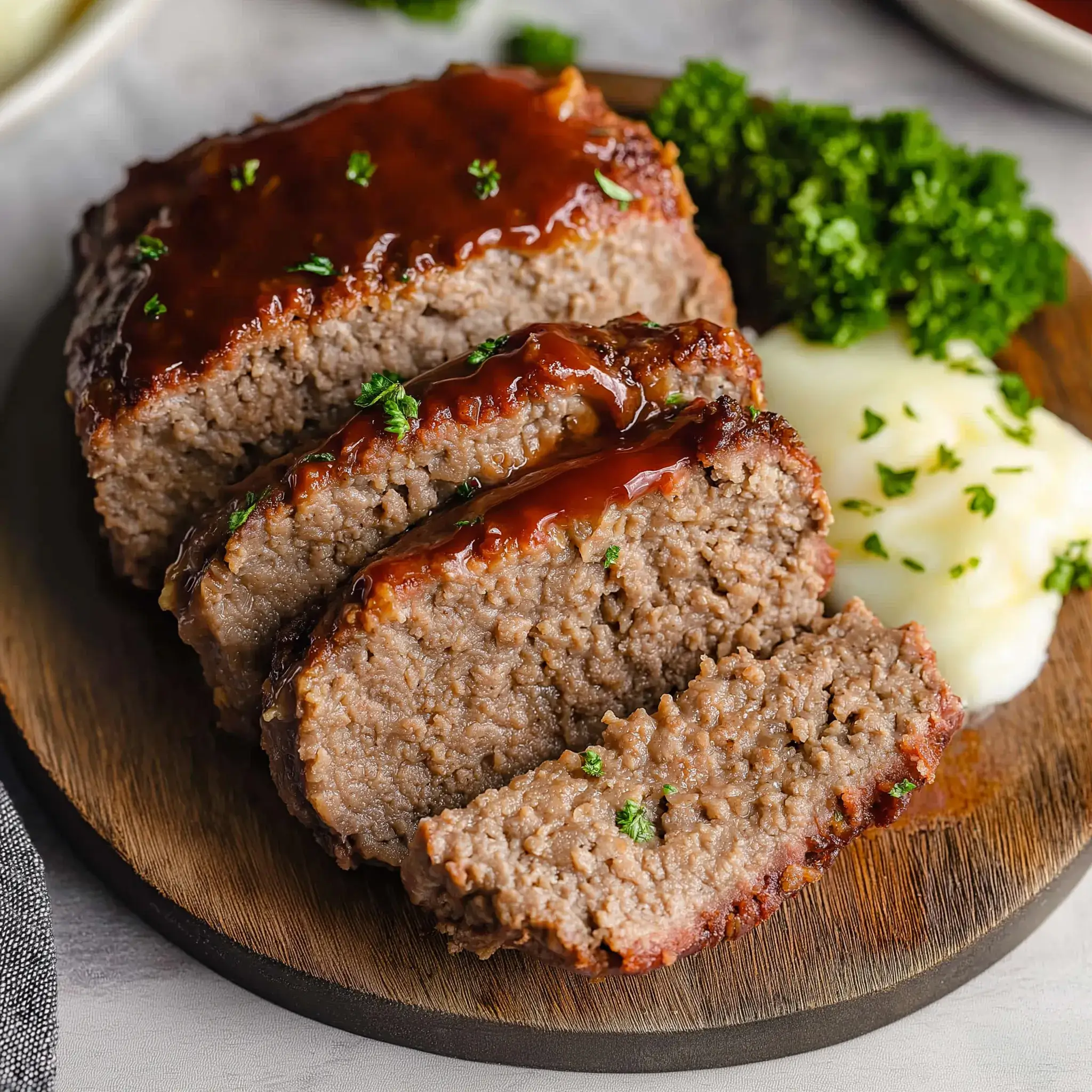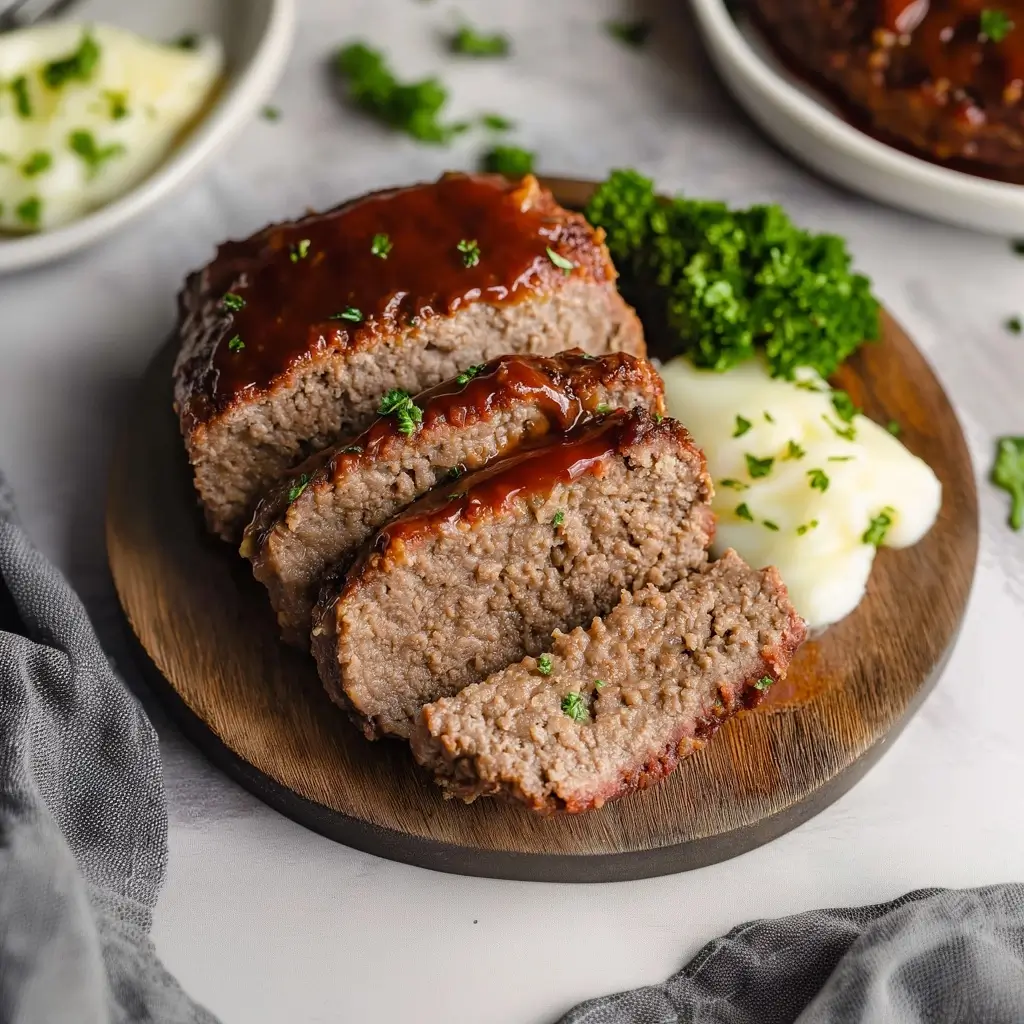 Save
Save
This meatloaf recipe transforms humble ground beef into a juicy, flavor-packed dinner that brings everyone to the table. The perfect balance of seasonings and a tangy-sweet glaze make this version stand out from ordinary meatloaf.
I developed this recipe after years of disappointing restaurant meatloaf experiences. What started as a weeknight experiment has become our family's most requested Sunday dinner, especially when company is coming.
Ingredients
- Ground beef Use 80/20 lean to fat ratio for the perfect balance of flavor and juiciness without excess grease
- Breadcrumbs Italian seasoned crumbs add flavor while helping bind the mixture and retain moisture
- Eggs Create structure and help hold everything together during baking
- Milk Soaks the breadcrumbs and adds exceptional moisture to the finished meatloaf
- Onions Sautéed beforehand for sweet flavor without crunchy texture in the final dish
- Chili sauce The secret ingredient that adds tang and depth to both the meat mixture and glaze
- Italian seasoning Provides classic herb flavor without having to measure multiple spices
- Fresh parsley Brightens the rich flavors and adds subtle freshness throughout
Step-by-Step Instructions
- Prepare the Pan
- Line a rimmed baking sheet with foil and spray with cooking spray. This makes cleanup easy and prevents sticking. The rimmed edges catch any drippings while the open top allows better browning than a loaf pan.
- Sauté the Onions
- Cook diced onions in butter over medium-low heat until translucent and just beginning to caramelize. This takes about 5 minutes and develops natural sweetness while eliminating harsh raw onion flavor. Allow them to cool completely before adding to the meat mixture.
- Create the Panade
- Mix eggs, milk, and breadcrumbs in a bowl and let stand for 5-10 minutes. This creates a panade that keeps the meatloaf juicy. The breadcrumbs absorb the liquid and later release it during cooking, preventing the meat from drying out.
- Mix the Meatloaf
- Add ground beef, cooled onions, ketchup, seasonings, and salt and pepper to the breadcrumb mixture. Gently combine with your hands just until ingredients are evenly distributed. Overmixing will result in a dense, tough texture.
- Shape and Bake
- Form mixture into an 8x4 inch loaf on the prepared pan. The free-form shape allows excess fat to drain away while creating more delicious caramelized exterior. Bake at 350°F for 40 minutes to develop flavor.
- Add the Glaze
- Combine chili sauce, ketchup and brown sugar for the perfect tangy-sweet topping. Spread over partially cooked meatloaf and continue baking 15-30 minutes until internal temperature reaches 160°F for food safety.
- Rest Before Serving
- Allow meatloaf to rest for 10 minutes before slicing. This critical step lets juices redistribute throughout the meat instead of running out when cut, ensuring each slice stays moist.
 Save
Save
The chili sauce in this recipe completely transforms ordinary meatloaf into something special. My grandmother always used it in her version, and that distinctive tangy flavor instantly transports me back to her kitchen. When my children smell this meatloaf baking, they know something special is happening.
Make-Ahead Options
This meatloaf can be prepared up to 24 hours before baking. Simply shape the raw mixture on the baking sheet, cover tightly with plastic wrap, and refrigerate. Remove from the refrigerator 30 minutes before baking to take the chill off, then proceed with the recipe. The glaze can also be mixed ahead and stored separately.
Perfect Leftovers
Leftover meatloaf stays delicious for up to 4 days when refrigerated in an airtight container. For the best texture, reheat slices in a skillet with a bit of butter until warmed through. This creates a beautiful caramelized exterior while keeping the inside moist. For sandwiches, try toasting the bread and adding a slice of meatloaf with extra ketchup.
Freezer Instructions
This meatloaf freezes beautifully both before and after cooking. To freeze uncooked meatloaf, shape on a parchment-lined baking sheet and freeze until solid. Wrap tightly in plastic wrap followed by foil and freeze for up to 3 months. Thaw overnight in the refrigerator before baking. For cooked meatloaf, slice before freezing for easy portioning.
 Save
Save
Recipe Q&A
- → Why should I cook onions before adding them to meatloaf?
Cooking the onions in butter first softens them and removes their harsh raw flavor. This creates a more mellow, sweet onion taste that blends beautifully with the beef. Raw onions can sometimes remain crunchy and overpowering in the finished dish.
- → What is chili sauce and can I substitute it?
Chili sauce isn't spicy but rather a zesty condiment similar to ketchup with more tang and less sweetness. It's typically found near ketchup in stores. If unavailable, you can substitute with extra ketchup or even BBQ sauce for a different but delicious flavor profile.
- → Why use a baking sheet instead of a loaf pan?
Using a baking sheet allows heat to circulate around the meatloaf, creating a delicious browned crust on more surfaces. A loaf pan causes the meat to steam in its juices, preventing browning and creating nowhere for excess fat to drain away, potentially resulting in a soggy bottom.
- → Why soak the breadcrumbs in milk?
Soaking breadcrumbs in milk creates a panade - a culinary technique that helps keep ground meat incredibly moist during cooking. The milk-soaked breadcrumbs distribute moisture evenly throughout the meatloaf and prevent the proteins from binding too tightly, which would result in a tough, dry texture.
- → How do I know when my meatloaf is done cooking?
The most reliable method is using an instant-read thermometer inserted into the center of the meatloaf, which should read 160°F. Visually, the meatloaf should be browned on the outside with the glaze caramelized. Cooking time may vary based on your oven, the size/shape of your meatloaf, or starting meat temperature.
- → Why does the meatloaf need to rest before slicing?
Resting allows the juices to redistribute throughout the meat instead of running out when cut immediately. This 10-minute rest period ensures each slice stays moist and holds together better. Cutting too soon results in dry meatloaf and messy slices that fall apart.
